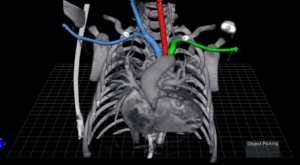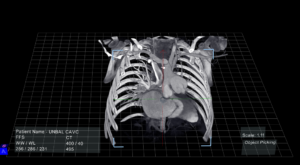Bringing Virtual Reality and 3D Printing Together for Surgical Planning — A Few Questions For: EchoPixel
![]() Medical applications for 3D technologies simply never cease to amaze me. The intricacies of the human body are best served by a three-dimensional understanding, which flat CT or MRI scans cannot produce. It is to this end that we see an ever-increasing number of medical professionals turning to high-tech solutions for their patient-specific concerns. Among the many emerging tools in these professionals’ toolboxes is a new set bringing together virtual reality and 3D printing to enhance efficiency and accuracy for the medical field as EchoPixel this week has announced True 3D print support.
Medical applications for 3D technologies simply never cease to amaze me. The intricacies of the human body are best served by a three-dimensional understanding, which flat CT or MRI scans cannot produce. It is to this end that we see an ever-increasing number of medical professionals turning to high-tech solutions for their patient-specific concerns. Among the many emerging tools in these professionals’ toolboxes is a new set bringing together virtual reality and 3D printing to enhance efficiency and accuracy for the medical field as EchoPixel this week has announced True 3D print support.
Doctors using the latest suite of software tools from EchoPixel will be able to interact with virtual models of their patents’ anatomy and then seamlessly 3D print them for a hands-on experience. With a “print right, the first time” philosophy underlying the system, EchoPixel paid particular attention to user experience in their new release. Virtual reality tools from EchoPixel are already in use at such medical centers as Stanford University, UCSF, the Cleveland Clinic, and Cook Children’s Hospital — the last of these even having established a dedicated 3D lab bringing together 3D printing with EchoPixel technology for use in heart surgery applications.
“We’re excited to establish 3D virtual viewing as part of our 3D program. Having this technology, in addition to 3D printing capabilities, allows Cook Children’s cardiologists and cardiothoracic surgeons to improve the planning of complex procedures and surgeries. We believe this approach will eventually lead to less time in the operating room and fewer complications,” said Steve Muyskens, M.D., cardiologist at Cook Children’s Medical Center.
The new suite of software tools is built on the foundation of the company’s True 3D Viewer software, which converts DICOM data sets into life-sized VR models. Already able to virtually interact with the models, these users will now be able to set the desired anatomy and orientation, then send it off to be 3D printed facilitated by the new software tools. EchoPixel notes that benefits of 3D modeling in medical applications include:
- Improved communication and collaboration among different members of the surgical team, including surgeons and other OR staff
- Enhanced pre-operative planning and better interactive understanding of unique anatomy that can be used as a reference during surgery
- Mirror-image modeling used for reconstruction templates
- Practice on models for surgical residents resident work hours
- Increased patient education
“We believe there’s a revolution happening in 3D medical modeling, and it’s just getting started. 3D printing is a game changing technology, but it’s not yet accepted as a widely effective clinical tool, primarily due to the cost and time restrictions,” said EchoPixel CEO Ron Schilling. “EchoPixel’s Interactive Virtual Reality is a complementary technology that can enable truly effective 3D modeling for the first time. It has the potential to dramatically reduce time and cost investments.”
 As we see with increasing frequency, medical models created via 3D technologies can allow unprecedented preparation for complex surgical cases as doctors are able to examine all angles — literally — before even touching a scalpel. With the new software solution from EchoPixel set to streamline the process of creating these detailed models, I was eager to learn more about this offering. Fortunately, the company’s CEO was more than willing to answer A Few Questions For me to dig deeper into the new suite and what it might mean for the medical community.
As we see with increasing frequency, medical models created via 3D technologies can allow unprecedented preparation for complex surgical cases as doctors are able to examine all angles — literally — before even touching a scalpel. With the new software solution from EchoPixel set to streamline the process of creating these detailed models, I was eager to learn more about this offering. Fortunately, the company’s CEO was more than willing to answer A Few Questions For me to dig deeper into the new suite and what it might mean for the medical community.
How does True 3D stand to reduce the timing involved in the medical 3D modeling process?
“True 3D makes it easier and more efficient for medical professionals to create 3D models and export them to a 3D printer, ultimately minimizing the time required for the entire workflow. True 3D also allows medical professionals to import 3D models for quality assurance so that they can ‘print right, the first time’.”
How can surgeons expect to benefit from the use of EchoPixel’s new platform?
“Surgeons using True 3D will benefit from improved communication and collaboration among different members of the surgical team, from the radiologist to the OR staff. This also allows the surgical team to enhance their pre-operative planning and provides them with a better interactive understanding of unique anatomy that can be used as a reference during surgery.
Beyond the surgical team, patients and their families can more easily understand the procedure. Today, most patients find it difficult to understand their own CT or MRI images – it requires years of medical training. However, with True 3D, the intuitive nature of the Interactive Virtual Reality objects allows physicians to better educate patients before and after surgery.”
What is the learning curve for medical professionals turning to 3D technologies including True 3D for the first time?
“Because True 3D is designed to be intuitive, medical professionals – and even those without medical training – can grasp the technology and confidently interact with the system within minutes. The Interactive Virtual Reality objects are the closest mirror to the real life object.”
What sort of timeline do you expect for more saturated adoption of virtual reality and 3D printing in the medical arena?
“We’re seeing a rapid increase in the number of medical professionals adopting 3D printing and virtual reality, but it’s just getting started. There’s still an enormous, unrealized potential for this technology to transform the medical industry.”
 How does True 3D complement 3D printing capabilities?
How does True 3D complement 3D printing capabilities?
“3D printing is a game changing technology, but it’s not yet accepted as a widely effective clinical tool, primarily due to the cost and time restrictions. EchoPixel’s Interactive Virtual Reality is a complementary technology that can enable truly effective 3D modeling for the first time. It has the potential to dramatically reduce time and cost investments.
Several limitations exist with current 3D printing technologies. First, 3D printed objects are limited in replicating the dynamic properties of organs. Second, the current software requires a great deal of human input to produce a 3D model capable of being printed. Finally, visualizing complex lesions or guiding devices while simulation procedures sometimes requires the printed models to be pellucid or have static cut planes depending on the viewing angle. Together, these limitations often make 3D printing cost and time prohibitive while also failing to deliver the desired level of accuracy.
EchoPixel’s True 3D is a complementary tool that helps address these limitations in 3D printing. It provides fast and easy methods to create 3D models and export them to a 3D printer. It also allows medical professionals to import 3D models for quality assurance of complex, multiple object print cases.”
As more medical professionals turn to 3D technologies in their practices, we can expect to see upswings in the quality of healthcare available. Precision in the creation of medical models is of the utmost importance for the patient, and a seamless experience in creating these models will help to streamline the process for busy physicians and others in medical labs; the software behind these endeavors must be able to support the demands of busy hospital environments, and efforts and product introductions such as this one from EchoPixel are showing important progress in this arena.
You can learn more about EchoPixel at their website, and check out some videos for a closer look at their technology. Discuss in the EchoPixel forum at 3DPB.com.
[All images/video: EchoPixel]
Subscribe to Our Email Newsletter
Stay up-to-date on all the latest news from the 3D printing industry and receive information and offers from third party vendors.
You May Also Like
Precision at the Microscale: UK Researchers Advance Medical Devices with BMF’s 3D Printing Tech
University of Nottingham researchers are using Boston Micro Fabrication‘s (BMF) 3D printing technology to develop medical devices that improve compatibility with human tissue. Funded by a UK grant, this project...
3D Printing Webinar and Event Roundup: April 21, 2024
It’s another busy week of webinars and events, starting with Hannover Messe in Germany and continuing with Metalcasting Congress, Chinaplas, TechBlick’s Innovation Festival, and more. Stratasys continues its advanced training...
3D Printing Webinar and Event Roundup: March 17, 2024
It’s another busy week of webinars and events, including SALMED 2024 and AM Forum in Berlin. Stratasys continues its in-person training and is offering two webinars, ASTM is holding a...
3D Printed Micro Antenna is 15% Smaller and 6X Lighter
Horizon Microtechnologies has achieved success in creating a high-frequency D-Band horn antenna through micro 3D printing. However, this achievement did not rely solely on 3D printing; it involved a combination...
































